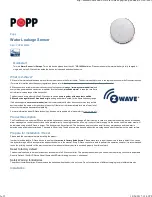
The device can be placed on any flat surface in front or below home appliances such as dishwashers or washing machines as long as the opening gap is higher
than 25 mm. The recommended way to install the device is to mount the mounting base on the lower part of the wall closed to the point of water leakage control.
When mounted on a wall the device can be attached using the double sides tape on the backside of the device. However it is recommended to screw the device
holder to the wall as seen above.
The detecting head is then connected to the base using a 90 cm long cable and can be placed even on placed with very limited room. To open the device turn the
two parts of the enclosure against each other. The Z-Wave button is inside the enclosure.
Inclusion/Exclusion
On factory default the device does not belong to any Z-Wave network. The device needs to be
added to an existing wireless network
to communicate with the
devices of this network. This process is called
Inclusion
.
Devices can also be removed from a network. This process is called
Exclusion
. Both processes are initiated by the primary controller of the Z-Wave network. This
controller is turned into exclusion respective inclusion mode. Inclusion and Exclusion is then performed doing a special manual action right on the device.
Inclusion
Single click the internal Button. The red LED will light up to confirm the action.
Exclusion
Single click the internal Button. The red LED will light up to confirm the action.
Product Usage
Once placed on the desired location the device will alarm wirelessly and locally in case of a detected water leakage. The LED starts blinking and - if configured this
way - the buzzer will sound. The sound will stop after 3 minutes even if the reason for the alarm was not removed. The LED will however continue to blink.
Node Information Frame
The Node Information Frame (NIF) is the business card of a Z-Wave device. It contains information about the device type and the technical capabilities. The
inclusion and exclusion of the device is confirmed by sending out a Node Information Frame. Beside this it may be needed for certain network operations to send
out a Node Information Frame. To issue a NIF execute the following action: Single click the internal Button. The red LED will light up to confirm the action.
Communication to a Sleeping device (Wakeup)
This device is battery operated and turned into deep sleep state most of the time to save battery life time. Communication with the device is limited. In order to
communicate with the device, a static controller
C
is needed in the network. This controller will maintain a mailbox for the battery operated devices and store
commands that can not be received during deep sleep state. Without such a controller, communication may become impossible and/or the battery life time is
significantly decreased.
This device will wakeup regularly and announce the wakeup state by sending out a so called Wakeup Notification. The controller can then empty the mailbox.
Therefore, the device needs to be configured with the desired wakeup interval and the node ID of the controller. If the device was included by a static controller this
controller will usually perform all necessary configurations. The wakeup interval is a tradeoff between maximal battery life time and the desired responses of the
device. To wakeup the device please perform the following action: Double click the internal Button. The red LED will light up to confirm the action.
Quick trouble shooting
Here are a few hints for network installation if things dont work as expected.
Make sure a device is in factory reset state before including. In doubt exclude before include.
1.
http://manuals-backend.z-wave.info/make.php?lang=en&sku=POPE700052
2 of 5
10/24/2017, 12:05 PM























